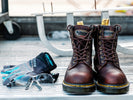
What are Safety Shoes and When Do You Need Them?
, by Ed Stone, 6 min reading time

, by Ed Stone, 6 min reading time
Prior to the 20th century, it was significantly cheaper to replace an employed worker than to implement safety measures. With the rise of the Industrial Revolution came a massive influx of workers and companies that depended on these new measures to complete daily functions successfully. It also introduced workers’ unions and safety requirements we still have today. Thanks to these safety standards, workers in construction, transportation, manufacturing, and even food and retail are required to wear a comfortable safety shoe daily. Currently, Safety shoes and work safety boots are available in a variety of styles including women's safety boots and men's steel toe shoes, slip-on work boots, lace ups, steel toe, composite toe work shoes, moc toe and safety sneakers. In this article, we will explain where this proper footwear started, what makes a safety shoe, and the different types of safety shoes and why they are worn.
When you think of work injuries, foot injuries may not be high on your list of worries, but they are more common than you’d think. At least 60,000 foot injuries lead to missed workdays every year. The cost of this to companies can reach over $950 million dollars. When you measure the cost of these injuries with the cost of requiring your workers to wear some form of safety work boot, you can see the savings.
With an understanding of the reasons behind requiring safety shoes in any given work environment, you may be curious about the origins of the safety work boot concept. The first protective shoe that employed workers wore were called Sabots. These had a simple, hollowed-out wooden shoe design that kept French and British farmers’ feet safe from falling objects.This was a common footwear choice until the Industrial Revolution when workers started throwing Sabots into machinery to stop production during protests.
In the 1930s, industrial workplace safety issues were beginning to be addressed, and the Red Wing Shoes Company started to make a steel toe boot in Germany for workers and military officers not commissioned in wartime. Safety issues continued to take precedence after the war. In the 1970s, the United States Congress passed the Occupational Safety and Health Act to ensure safe and healthy work conditions for employees. This act included the creation of the Occupational Safety and Health Administration (OSHA) to enforce standards relating to workers’ safety.
Leading up to today’s modern safety footwear, men's and women's safety shoes were designed with only a safety toe. These were historically steel, but eventually included Aluminum Alloy, Composite Materials, and Carbon Fiber toe shoes. These composite toe vs steel toe shoes were examined and tested to follow standards set in place by the American National Standards Institute (ANSI). As time went on, foot protection grew to mean protecting your toes, ankles, and feet from hazard and injury. This led to safety boot standards being newly regulated by the American Standards for Testing and Materials (ASTM), with areas of concern growing to include falling objects, stepping on sharp objects, heat and cold, wet and slippery surfaces, and exposure to corrosive chemicals. As many job sites contain risks of slipping and falling due to slick surfaces, we offer a broad collection of slip-resistant protective shoe options for men and women to help mitigate the chances of foot injury.
OSHA and ASTM standards now cover performance requirements, testing standards, and standard labeling. As every work environment is different, the responsibility to require specific safety shoes falls on employers. OSHA requires employers to assess the workplace to determine hazards that may necessitate Personal Protective Equipment (PPE). Failure to comply with OSHA requirements can result in thousands of dollars of fines.
Different types of safety shoes and why they’re worn for added foot protection
According to OSHA standard 1910.132 (d)(1), employers must assess the workplace to determine if hazards necessitate PPE. Protective footwear must be used when employees are in danger of foot injuries due to falling or rolling objects, objects piercing the sole, or where employees' feet are exposed to electrical hazards according to OSHA standard 29CFR 1915.156 (a).
The following footwear performance requirements are addressed in the ASTM F2413 standard:
The responsibility for protective footwear lies mainly with the employer, but employees should be informed about their safety shoe options and when safety shoes are required. We hope this article helped explain the history and reasons for protective safety shoes and what types of shoes there are available.
At Boot World, we offer several brands and styles like men’s Caterpillar work boots and CAT women’s work boot styles along with Wolverine work boots, Timberland PRO boots, and KEEN Utility boots. Have more questions about safety footwear? Visit one of Boot Word’s locations today to get expert advice and input!
Ed Stone brings over 45 years of footwear knowledge and passion to his role as President of Boot World, a family-owned company and an industry leader in safety and occupational footwear. A second generation "shoe dog” Ed's footwear knowledge is unparalleled, serving as an informal advisor for some of the worlds largest footwear brands including Wolverine, Timberland PRO, and Reebok Works.
A lifelong Southern California resident, and ardent conservationist, Ed enjoys hiking and open water swimming.